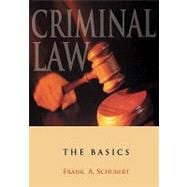
Note: Supplemental materials are not guaranteed with Rental or Used book purchases.
Purchase Benefits
What is included with this book?
| Each chapter concludes with Discussion Questions | |
| A Note to Students | |
| Introduction to Criminal Law | |
| Criminal Law | |
| The Common Law | |
| Tradition Holland v. State of Florida Deciding | |
| What Conduct Is Deemed Criminal | |
| Common Law and Criminal | |
| Codes Criminal and Civil | |
| Law Katko v. Briney Classification of Offenses | |
| Felonies and Misdemeanors | |
| Federal Form of Government | |
| Federal Criminal Law Direct | |
| Federal Interests Indirect | |
| Federal Interests | |
| The Purposes of Punishment | |
| Retribution Gregg v. Georgia | |
| Deterrence Incapacitation | |
| Rehabilitation Procedural | |
| Considerations Jury Trials vs. Bench Trials | |
| The Order of Trial Jury Selection | |
| Challenges to the Panel Opening Statements | |
| The Presentation of the Prosecution's Case in Chief | |
| The Presentation of the Defendant's Case Case in Chief | |
| The Presentation of the Prosecution's Rebuttal Case | |
| The Defense Motion for Acquittal Closing Arguments Jury Instructions | |
| The Jury's Verdict Motions After Verdict | |
| The Supremacy Clause | |
| Constitutional Limitations on the Definition and Punishment of Criminal Offenses | |
| Prohibitions Against Bills of Attainder | |
| Due Process Substantive | |
| Due Process Precision Vagueness | |
| City of Chicago v. Jesus Morales et al. Overbreadth | |
| The Right to Privacy Griswold v. Connecticut | |
| Criminalizing Conduct Deemed Immoral Commonwealth of Pennsylvania v. Bonadio Commonwealth of | |
| Procedural Due Process "Megan's Law" State v. Bani Equal | |
| Protection Loving v. Commonwealth of Virginia | |
| Prohibitions Against Ex Post Facto | |
| Laws Cruel and Unusual Punishment Barbaric | |
| Punishments Gregg v. Georgia | |
| Disproportionate Punishments | |
| Harmelin v. Michigan Atkins v. Commonwealth Virginia | |
| General Principles of Criminal Liability | |
| The Criminal Act/Actus Reus Criminal Act or Status? | |
| Robinson v. California Voluntariness | |
| State of Arizona v. Miguel Angel | |
| Lara Criminal Liability in the Absence of an Act (Omissions) | |
| Commonwealth of Pennsylvania v. John Barry | |
| Kellam Is Possession an Act? Byrd v. Texas | |
| Presumptions and Actus Reus Ulster County Court v. Allen | |
| Double Jeopardy Considerations Brown v. Ohio Criminal | |
| Intent/Mens Rea Mala in Se Offenses | |
| Mala Prohibita Offenses Defining Criminal Intent | |
| The Traditional Common Law Approach State v. Gordon | |
| The Doctrine of Transferred Intent People v. Scott | |
| The Model Penal Code Approach Furr v. State Presumptions and Criminal | |
| Intent Sandstrom v. Montana Concurrence | |
| Strict Liability | |
| The People v. Juan J. Coria Causation | |
| Factual Causation Proximate | |
| Causation Commonwealth v. Berggren | |
| Independent Intervening Cause | |
| People v. Saavedra-Rodriguez | |
| Complicity and Vicarious | |
| Liability Complicity Complicity | |
| Under the Common Law People v. Norris | |
| Proving Complicity State v. Mobbley Oregon v. Allred | |
| Table of Contents provided by Publisher. All Rights Reserved. |
The New copy of this book will include any supplemental materials advertised. Please check the title of the book to determine if it should include any access cards, study guides, lab manuals, CDs, etc.
The Used, Rental and eBook copies of this book are not guaranteed to include any supplemental materials. Typically, only the book itself is included. This is true even if the title states it includes any access cards, study guides, lab manuals, CDs, etc.